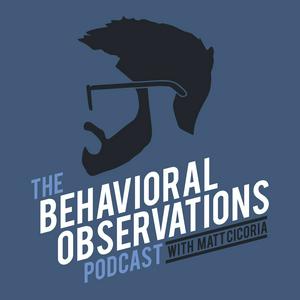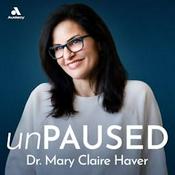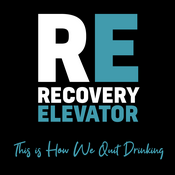The Behavioral Observations Podcast with Matt Cicoria
Matt Cicoria

Latest episode
Available Episodes
5 of 320
- Smarter Study Strategies Using Cover, Copy, and Compare: Session 318 with Sarah FramptonIn this episode, I sit down with Dr. Sarah Frampton, who conducts research on, amongst other things, improving how we teach, learn, and organize information using behavior-analytic strategies. We explore her career journey, her research on graphic organizers and the Cover, Copy, Compare (CCC) strategy, and the broader implications for stimulus equivalence, educational technology, and effective teaching. In This Episode, You'll Learn: How Sarah's unconventional path led her from economics and psychology into Applied Behavior Analysis (ABA). Why note-taking and structured learning strategies, like CCC, matter for retaining and applying complex information. How stimulus equivalence principles can enhance learning beyond direct instruction. Insights from Sarah's research combining CCC with graphic organizers, including practical takeaways for educators and learners (see Frampton, Vesely and Jackson, 2025). How visual learning tools and educational technology can improve engagement and retention. Strategies for training learners to use these approaches independently and effectively. Highlights From Our Conversation: Sarah's Path Into ABA Sarah shares how a thesis requirement and a Craigslist job posting led her to ABA, including formative experiences working with Dr. Alice Shillingsburg at the Marcus Autism Center. These experiences sparked her interest in efficient, broadly applicable learning strategies. Why Note-Taking Strategies Matter We discuss the value of graphic organizers and the Cover, Copy, Compare (CCC) strategy: Graphic organizers visually display relationships between concepts. CCC is a structured, active-response method that strengthens memory, similar to flashcards. Sarah emphasizes how behavior-analytic techniques can support higher-order thinking processes often considered "cognitive." CCC and Stimulus Equivalence Sarah walks through stimulus equivalence with clear examples, showing how teaching certain relations can produce broader learning without direct instruction. She also highlights a study where CCC and graphic organizers helped learners prepare for tests—even under intentionally challenging conditions. Graphic Organizers in Action Key findings from Sarah's research: Learners who drew more structured organizers performed better. Teaching organizer use during test conditions did not hinder performance. Visualizing relationships among stimuli predicted task success. Training Learners to Use These Strategies Sarah outlines her training sequence, including pre-tests, video instruction, practice with familiar material, and application to abstract stimuli. A core goal was strategy generalization—ensuring learners could apply CCC to new material independently. Fig. 1 from Frampton, et al. (2025) Fig. 2 from Frampton, et al. (2025) Research Findings Most participants quickly mastered abstract relations and passed post-tests after brief training. Notably, all participants used the CCC strategy—some even more meticulously than required. Educational Technology, Engagement, and Mediation Participants reported the educational technology intervention was easy to use and helpful, contrasting with high dropout rates in similar studies. Sarah also describes how participants naturally used private verbal behavior, such as naming stimuli or creating stories, to aid learning. Visual Learning Tools in ABA We discuss the broader application of visual supports—graphic organizers, flashcards, handwriting—and their role in enhancing learning efficiency for both adults and children with autism. Looking Ahead Sarah previews her upcoming presentation at the Verbal Behavior Conference, covering generative learning and assessment tools. We also explore how collaboration and community can reduce burnout and increase long-term job satisfaction in ABA in the "advice for the newly-minted" segment. Resources & Links Session 287: BiDirectional Naming with Caio Miguel. Session 80: Verbal Behavior and Relational Frame Theory, with David Palmer and Josh Pritchard. Shillingsburg, et al. (2016). A Preliminary Procedure for Teaching Children with Autism to Mand for Social Information. Frampton and Linehan (2024). The effects of a training package to teach note taking on the formation of equivalence classes. Sponsor shoutouts! Office Puzzle: A thriving ABA practice depends on systems that actually support your team, not slow them down. If you've struggled with software that's buggy, hard to navigate, or offers little support when you need it most, you're not alone. That's why so many practices are switching to Office Puzzle. Go to officepuzzle.com/bop to learn more! Frontera. Consider taking a demo of Frontera's Assessment Builder and see how the ethical application of AI technologies can help you serve clients and save you time! Your first assessment report is free. And if you use code BOP25 you'll get an additional five assessments for just $100. So head to fronterahealth.com to check it out! MindBodyBehavior's Certified Health Coach Program. If you're a BCBA looking to use your ABA skills to help people live healthier lifestyles, learn how to do it the right way, with expert instruction, mentoring, and guidance from Sarah Burby. Better still, podcast listeners can save $$$ by using the code BOP10 at check out. Click here to learn more! The 2026 Stone Soup Conference! This is one of the best values in the online conference space. I'm actually going to be one of the speakers at this year's event, along with a great cast of other characters you're probably familiar with. Save on your registration by using promo code PODCAST26! The 2026 Verbal Behavior Conference! Taking place March 26–27, 2026, in Austin, Texas, or livestream and on-demand on BehaviorLive. Presenters will include Drs. Mark Sundberg, Patrick McGreevy, Caio Miguel, Alice Shillingsburg, Sarah Frampton, Andresa De Souza, and Danielle LaFrance will share how Skinner's analysis of verbal behavior can guide the assessment and treatment of generative learning challenges in children with autism and other developmental disabilities. And don't miss the special pre-conference workshop on Wednesday, March 25.--------1:35:54
- Eye Contact and AI in ABA Treatment: Session 317 with Francesca degli EspinosaIn Session 317, I sit down with Dr. Francesca Delia Espinoza to revisit one of the most foundational—but often misunderstood—topics in behavior analysis: eye contact. We explore why eye contact shouldn't be treated as a simple objective, but instead understood within its broader social and developmental context. Francesca explains how eye contact is better re-framed as "eye-looking," and why behavior analysts need a strong conceptual foundation for evaluating when, how, and why to teach it. We discuss her recent paper in Perspectives on Behavior Science, which encourages practitioners to analyze the controlling variables behind eye contact rather than relying on rote teaching procedures. We then shift into the role of eye contact in autism development and early intervention. Francesca discusses how deviations in gaze behavior can influence a child's learning trajectory, and why early, naturally occurring social contingencies can make such a significant difference. We also touch on the potential aversiveness of eye contact for some individuals, and how to navigate that ethically and effectively. Our conversation expands into related research on social media, gaze avoidance, and how adults and children with autism engage differently with eye-related cues online. Francesca also talks about her Substack newsletter, "What Darwin Taught Me," which blends behavioral science with accessible and engaging writing. From there, we explore her creative work in conceptual fiction, including her "Aura" series from her Substack Newsletter — a not-too-distant science-fiction world where behavior analysts work alongside AI systems that analyze sessions, generate programs, and support day-to-day clinical tasks. This leads us into a broader discussion about the role of AI in applied behavior analysis, including its promises, limitations, and the importance of preserving hands-on clinical expertise. Francesca describes one of the short stories in the Aura series about behavior analysts who travel to developing countries, only to realize their reliance on technology becomes a liability when the systems fail. It's a striking reminder that behavior change happens in real time, and nothing replaces skilled human interaction. We close by reflecting on how emerging technologies—AI, automation, and digital platforms—might shape the future of ABA for better or worse. Resources and References Mentioned: Francesca's Substack: "What Darwin Taught Me" (Aura storyline here) Stromberg, et al. (2025). Shaping Social Eye Contact in Children With Autism Via Telehealth: A Parent-Implemented Intervention Skinner (1986): "What Is Wrong With Daily Life in the Western World?" The Craft of Applied Behavior Analysis: Session 181 with Francesca Degli Espinosa Eye Contact, Joint Attention, and Autism: Session 238 with Francesca Degli Espinosa Cline (2012). Ready Player One (pro tip: skip the movie, read the book) The Matrix Sponsor Shoutouts! Frontera. Consider taking a demo of Frontera's Assessment Builder and see how the ethical application of AI technologies can help you serve clients and save you time! Your first assessment report is free. And if you use code BOP25 you'll get an additional five assessments for just $100. So head to fronterahealth.com to check it out! MindBodyBehavior's Certified Health Coach Program. If you're a BCBA looking to use your ABA skills to help people live healthier lifestyles, learn how to do it the right way, with expert instruction, mentoring, and guidance from Sarah Burby. Better still, podcast listeners can save $$$ by using the code BOP10 at check out. Click here to learn more! HRIC Recruting. Cut out the middleman and speak directly with Barbara Voss, who's been placing BCBAs in great jobs all across the US for 15 years. The 2026 Stone Soup Conference! This is one of the best values in the online conference space. I'm actually going to be one of the speakers at this year's event, along with a great cast of other characters you're probably familiar with. Save on your registration by using promo code PODCAST26! Behavior University. Their mission is to provide university quality professional development for the busy Behavior Analyst. Learn about their CEU offerings, including their 8-hour Supervision Course, as well as their RBT offerings over at behavioruniversity.com/observations. Don't forget to use the coupon code, PODCAST to save at checkout! The 2026 Verbal Behavior Conference! Taking place March 26–27, 2026, in Austin, Texas, or livestream and on-demand on BehaviorLive. Presenters will include Drs. Mark Sundberg, Patrick McGreevy, Caio Miguel, Alice Shillingsburg, Sarah Frampton, Andresa De Souza, and Danielle LaFrance will share how Skinner's analysis of verbal behavior can guide the assessment and treatment of generative learning challenges in children with autism and other developmental disabilities. And don't miss the special pre-conference workshop on Wednesday, March 25.--------1:17:36
- Making ABA Research Matter: Practical Dissemination Strategies for Behavior Analytic Scholars, Inside JABA 25Episode Overview In this special episode of the Behavioral Observations Podcast, I had the honor of celebrating the 25th installment of the Inside JABA Series. This one was particularly meaningful because it also marks the final appearance of Dr. John Borrero in his role as Editor-in-Chief of The Journal of Applied Behavior Analysis. I invited John to reflect on his three-year tenure—what he learned from reading an enormous volume of manuscripts, how his thinking evolved, and why adapting our language is essential if we want behavior analysis to reach broader audiences. From there, we transitioned into an informative conversation with Dr. Nate Call from Emory University. Nate's recent work focuses on how we can better disseminate applied behavior analysis, not just distribute it. His paper, Scholarship as an Operating Class: Strategies and tactics for increasing dissemination of applied behavior analysis, has already shifted how I think about how our field packages and shares research. In this episode, Nate walked us through actionable strategies for increasing the reach and impact of our work. Key Topics Covered in This Episode 1. John Borrero's Reflections from the Editor's Chair John looked back on his three years as Editor-in-Chief, and I asked him what surprised him most. He talked about: How important clear, accessible language is for dissemination Why behavior analysts must evolve how we communicate without losing our scientific roots Efforts to make JABA papers more accessible through translated articles What it's like to manage a massive editorial workflow and team 2. The Real Difference Between Dissemination and Distribution Nate clarified something that—and I'll admit—I hadn't always thought deeply about: there's a big difference between making your work available and ensuring your work is actually used. Nate described it like: Distribution = scattering seeds Dissemination = preparing the soil so they actually grow He also explained why early-career researchers often focus on distribution out of necessity, and how we can transition to more deliberate dissemination strategies over time. 3. Scholarship as an Operant Class Nate walked me through the framework behind his recent paper. He described scholarly behavior as something shaped by contingencies—just like anything else. We talked about: How individual and systemic consequences shape publishing choices Why some of the most high-impact papers come from individuals rather than large labs Concrete strategies we can use to increase the visibility and influence of our work 4. Boundary Encounters and Second-Generation Innovations I asked Nate about how ideas move between disciplines, and he introduced the concept of boundary encounters. We discussed: Incoming vs. outgoing boundary encounters How second-generation innovations help behavior analysis reach audiences outside our traditional spaces Why these interactions are essential if we want ABA to have a broader societal impact 5. Expanding Our Methodological Toolkit We took a deep dive into methodology and talked about the strengths of single-subject designs—as well as their limitations. Nate made a compelling case for: When behavior analysts should consider Randomized Control Trials, implementation science, or mixed methods Why diversifying methodologies helps us answer questions that matter to educators, policymakers, and grant reviewers What we lose when we rely exclusively on traditional single-subject approaches 6. Participatory Action Research and Social Validity I asked Nate to explain participatory action research, and he shared a powerful example involving first responders and families in crisis situations. He emphasized: The importance of involving stakeholders early How PAR elevates social validity and context Why many federal funders now expect qualitative or participatory components How behavior analysts can begin building these skills, even if it feels unfamiliar 7. Measuring Our Impact More Effectively We also explored how to know whether dissemination is working. Nate and I discussed: Bibliographic network analysis Alt-metric measures The importance of citing intentionally to strengthen high-quality scholarship within the field 8. Nate's Advice for New BCBAs To close the episode, I asked Nate what he'd tell new behavior analysts entering the field. He encouraged them to: Read widely—far beyond behavior-analytic journals Become conversant in different research methods Build collaborations with experts in qualitative, mixed, and implementation-science approaches Think functionally about their own scholarly and professional behavior 9. Resources Mentioned in this Podcast Foxx (1996). Translating the Covenant: The behavior analyst as ambassador and translator Chawla (2020). Science is getting harder to read Critchfield, et al. (2013). A half century of scalloping in the work habits of the United States Congress Klein and Thompson (2025). Abundance The Prisoner's Dilemma Call et al. (2015). Clinical Outcomes of Behavioral Treatments for Pica in Children with Developmental Disabilities Critchfield (2002). Evaluating the function of Applied Behavior Analysis: A bibliometric analysis Inside JABA 18: How to Disseminate Behavior Analytic Technologies (CEU available!) Implementation Science and Participatory Action Research If you're passionate about increasing the influence of behavior analysis—whether through research, writing, teaching, or practice—this episode offers clear, functional guidance for how to do it.--------1:09:26
- Trauma-Informed Behavior Analysis, A Guide for BCBAs: Session 315 with Gabi Morgan and David AdamsThanks for joining me in Session 315 of The Behavioral Observations Podcast. In this episode, I spoke with Drs. Gabi Morgan and David Adams to dive deep into trauma-informed behavior analysis. Gabi brings her 30-year journey in the field—from undergrad roots to professorship at Bay Path University—while David shares his evolution from child and family therapy to clinical psychology, with a heavy focus on foster and adoptive parenting. Both guests are passionate about closing the divide between trauma therapy and behavioral strategies, and they credit mentors like Dr. Jeannie Golden for lighting the way. We kick things off by unpacking what trauma really means. In doing so, as a content warning, please be aware that we do make general references to a variety of traumatic and adverse experiences. Having said that, David walks us through SAMHSA's three-part definition: the event, the experience, and the effects. It's not the event itself that defines trauma—it's the individual's response. He introduces "adverse conditioning experiences" as a behavior-analytic twist on adverse childhood experiences (ACEs), spotlighting how negative associations get wired in through conditioning. From there, we contrast PTSD and complex PTSD. Same core symptoms (intrusive thoughts, avoidance, etc.), but complex PTSD adds prolonged exposure and three extra layers: impaired self-worth, rocky relationships, and emotional dysregulation. Gabi drives home a critical point: folks with developmental disabilities are at higher risk for trauma but often fly under the diagnostic radar. We need to get better at spotting trauma-related behaviors in this population. Screening, Brain Science, and Practical Strategies Screening is a big theme. We all agree behavior analysts aren't formally trained in assessment, but we have to be aware of how this is done. Gabi loves the Child Health and Development Institute's Child Trauma Screen (CTS), and the Massachusetts Child and Adolescent Needs and Strengths (Mass CANS) tool. David then nerds out on the neurobiology: trauma affects the amygdala (hypervigilance), hippocampus (memory glitches), hypothalamus (stress gone haywire), and frontal lobe (decision-making on the fritz). Enter the "amygdala hijack"—when fear short-circuits rational thought. Bottom line? Kids in fight-or-flight aren't in a teachable moment. Safety and calm have to come first. We close the show with actionable takeaways: risk-benefit analyses for every intervention (especially with histories of food neglect), "kind extinction" (empathy + withholding reinforcers), and the six pillars of trauma-informed care (safety, trustworthiness, peer support, collaboration, empowerment, cultural competence). TIC isn't a "hyphenated" ABA—it's the whole framework. Advice for new BCBAs? Seek trauma training, question "business as usual," and be the stable adult in a kid's chaotic world. Empathy, creativity, and reducing fear are your superpowers. Additional Resources Toward Trauma-Informed Applications of Behavior Analysis (Rajaraman, et al., 2021) Inside JABA 10 with Drs. Jenn Austin and Adithyan Rajaraman Dr. Camille Kolu's BOP episode on Buffers (a must listen!) 4th Annual Bay Path University Trauma-Informed Practice and ABA Conference David's book: Trauma-Informed Foster and Adoptive Parenting SAFE-T Assessment Training from Cusp Emergence University Sponsor Shoutouts! Frontera. Consider taking a demo of Frontera's Assessment Builder and see how the ethical application of AI technologies can help you serve clients and save you time! Your first assessment report is free. And if you use code BOP25 you'll get an additional five assessments for just $100. So head to fronterahealth.com to check it out! CEUs from Behavioral Observations. Learn from your favorite podcast guests while you're commuting, walking the dog, or whatever else you do while listening to podcasts. New events are being added all the time, so check them out here. The inaugural ABA CON CEU cruise, which launches on Royal Caribbean's Wonder of the Seas from February 16–20, 2026. Learn more about this cruise here. The 2026 Stone Soup Conference! This is one of the best values in the online conference space. I'm actually going to be one of the speakers at this year's event, along with a great cast of other characters you're probably familiar with. Save on your registration by using promo code PODCAST26! MindBodyBehavior's Certified Health Coach Program. If you're a BCBA looking to use your ABA skills to help people live healthier lifestyles, learn how to do it the right way, with expert instruction, mentoring, and guidance from Sarah Burby. Better still, podcast listeners can save $$$ by using the code BOP10 at check out. Click here to learn more! The 2026 Verbal Behavior Conference! Taking place March 26–27, 2026, in Austin, Texas, or livestream and on-demand on BehaviorLive. Presenters will include Drs. Mark Sundberg, Patrick McGreevy, Caio Miguel, Alice Shillingsburg, Sarah Frampton, Andresa De Souza, and Danielle LaFrance will share how Skinner's analysis of verbal behavior can guide the assessment and treatment of generative learning challenges in children with autism and other developmental disabilities. And don't miss the special pre-conference workshop on Wednesday, March 25. The discounted early-bird registration price is only available for a limited time, so get your ticket right away!--------1:10:18
- Supporting Schools in Hawaii with the Care Project: Session 314, Live from HABA 2025If you follow Behavioral Observations on Instagram, you might recall that I had the once-in-a-lifetime opportunity to travel to the 20th Annual Hawaii Association for Behavior Analysis conference to give the closing Keynote Address. I could devote an entire podcast episode to talking about all the wonderful people I met, the fun experiences I had, and the amazing sights I was able to take in. One of the biggest highlights though, was the opportunity to sneak in the following conversation I had with a panel of employees from Hawaii's Department of Education. It turns out that the State of Hawaii is doing some innovative work in bringing to bear specific behavioral technologies to improve the supports provided to children in school settings. This work is organized into a large scale endeavor that they have named The CARE Project. This panel consisted of Alysha Kim, Dodi Pritchett, Joshua Hoppe, and Sherene Hajiro. And before getting any further into this introduction, I want to thank my friends Katie Croce and Jamie Salter from Self and Match, for not only nudging us to have this conversation, but for also financially supporting it with a generous donation to the HABA. Here's what we talked about: The ways in which the Hawaii Department of Education differs from other state DOEs. The specific problems the CARE project was designed to address. The mindset shift from responding to preventing problem behavior. The DOE's collaboration with FTF and Emergent Learning. Specific case studies of successful interventions. How the DOE is collecting data for research purposes. The challenges of scaling these interventions in the face of staff turnover. How they turned the term "PFA/SBT" into a verb. How they see these types of supports evolving over time. Sponsor shoutouts! Frontera. Consider taking a demo of Frontera's Assessment Builder and see how the ethical application of AI technologies can help you serve clients and save you time! Your first assessment report is free. And if you use code BOP25 you'll get an additional five assessments for just $100. So head to fronterahealth.com to check it out! CEUs from Behavioral Observations. Learn from your favorite podcast guests while you're commuting, walking the dog, or whatever else you do while listening to podcasts. New events are being added all the time, so check them out here. Behavior University. Their mission is to provide university quality professional development for the busy Behavior Analyst. Learn about their CEU offerings, including their 8-hour Supervision Course, as well as their RBT offerings over at behavioruniversity.com/observations. Don't forget to use the coupon code, PODCAST to save at checkout! MindBodyBehavior's Certified Health Coach Program. If you're a BCBA looking to use your ABA skills to help people live healthier lifestyles, learn how to do it the right way, with expert instruction, mentoring, and guidance from Sarah Burby. Better still, podcast listeners can save $$$ by using the code BOP10 at check out. Click here to learn more! The 2026 Verbal Behavior Conference! Taking place March 26–27, 2026, in Austin, Texas, or livestream and on-demand on BehaviorLive. Presenters will include Drs. Mark Sundberg, Patrick McGreevy, Caio Miguel, Alice Shillingsburg, Sarah Frampton, Andresa De Souza, and Danielle LaFrance will share how Skinner's analysis of verbal behavior can guide the assessment and treatment of generative learning challenges in children with autism and other developmental disabilities. And don't miss the special pre-conference workshop on Wednesday, March 25, led by Dr. Emily Kerwin and Gina Zecchin-Tirri from All Points Behavior (formerly The Carbone Clinic). The discounted early-bird registration price is only available for a limited time, so get your ticket right away!--------1:03:11
More Health & Wellness podcasts
Trending Health & Wellness podcasts
About The Behavioral Observations Podcast with Matt Cicoria
The Behavioral Observations Podcast with Matt Cicoria is an interview-based show that features conversations with innovative scientists and practitioners in the field of Behavior Analysis. The podcast covers topics such as Autism, Functional Behavioral Assessment, Acceptance and Commitment Therapy, Functional Communication Training, Verbal Behavior, and more!
Podcast websiteListen to The Behavioral Observations Podcast with Matt Cicoria, Huberman Lab and many other podcasts from around the world with the radio.net app

Get the free radio.net app
- Stations and podcasts to bookmark
- Stream via Wi-Fi or Bluetooth
- Supports Carplay & Android Auto
- Many other app features
Get the free radio.net app
- Stations and podcasts to bookmark
- Stream via Wi-Fi or Bluetooth
- Supports Carplay & Android Auto
- Many other app features


The Behavioral Observations Podcast with Matt Cicoria
Scan code,
download the app,
start listening.
download the app,
start listening.






































